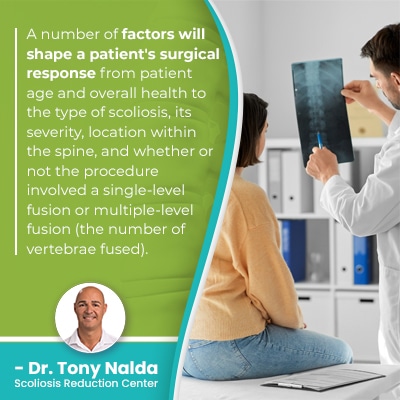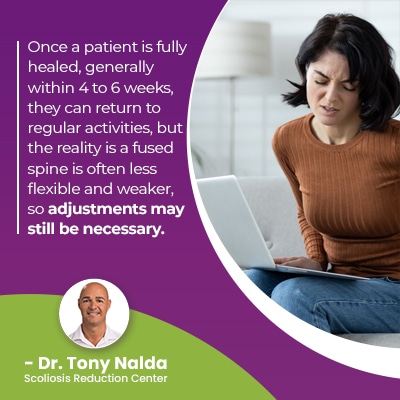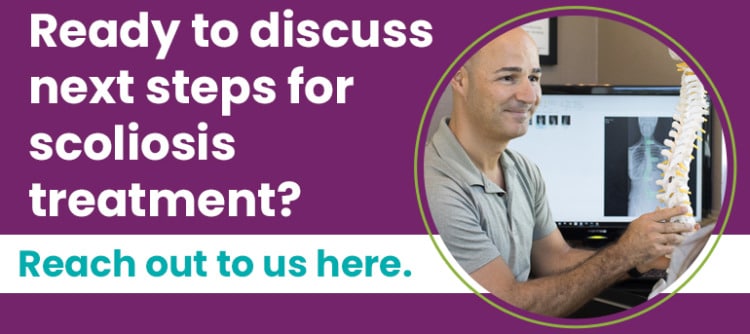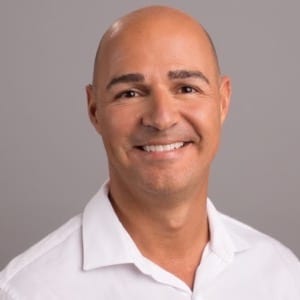Duration and Recovery: How Long Does Scoliosis Surgery Take?

Scoliosis surgery is a type of spinal fusion that can be risky and involve a lengthy recovery process. The goal of spinal fusion is to stop scoliosis from progressing, and the way it does so is by fusing the curve's most-tilted vertebrae into one solid bone and attaching metal rods to maintain the spine's position.
Scoliosis surgery duration varies but is largely based on the number of vertebrae fused. Recovery time is case-specific but time spent in hospital following the procedure is generally between 4 and 7 days, with most patients being cleared for regular activity within 4 to 6 weeks.
There is more than one treatment approach when it comes to scoliosis, and traditional scoliosis treatment tends to funnel patients towards scoliosis surgery.
Table of Contents
Scoliosis Surgery
There are different types of scoliosis surgery from traditional spinal fusion to vertebral body tethering, but the general concept is the same.
Scoliosis causes the spine to bend unnaturally to the side and rotate, so it's a complex 3-dimensional condition.
As a progressive condition, scoliosis gets worse over time; the size and rotation of the unhealthy spinal curve is increased and the condition's effects are becoming more noticeable and widespread.
The most common symptoms of childhood scoliosis involve postural changes like uneven shoulders and hips, and the most common symptom of adult scoliosis is pain caused by compression.
Scoliosis surgery has the goal of stopping progression; this isn't the same as working towards correcting the scoliosis.
Scoliosis surgery is part of a traditional scoliosis treatment approach, and it's more reactive than proactive because it doesn't start treatment while cases are mild but commonly recommends watching and waiting.
When/if a significant amount of progression occurs, and traditional bracing hasn't successfully reduced the curve size and stopped progression, spinal fusion surgery is commonly recommended when curve size is over 40 degrees.
What Does Spinal Fusion Surgery Involve?
Spinal fusion surgery involves identifying the curve's most-tilted vertebrae and fusing them into one solid bone so they don't become more unnaturally tilted over time: stopping progression.
Spinal fusion also commonly involves the removal of intervertebral discs that sit between adjacent vertebrae to be fused.
Once the vertebrae are fused, most often, metal rods are attached to the spine with pedicle screws to maintain its straight alignment.
So spinal fusion surgery will eliminate movement in the fused portion of the spine, but this can come at a cost: the spine's overall flexibility and range of motion.
Now, procedure length is difficult to estimate because each case is unique so every patient will have an equally-unique surgical response.
 A number of factors will shape a patient's surgical response from patient age and overall health to the type of scoliosis, its severity, location within the spine, and whether or not the procedure involved a single-level fusion or multiple-level fusion (the number of vertebrae fused).
A number of factors will shape a patient's surgical response from patient age and overall health to the type of scoliosis, its severity, location within the spine, and whether or not the procedure involved a single-level fusion or multiple-level fusion (the number of vertebrae fused).
The average length of spinal fusion surgery is between 4 and 8 hours; if there are any complications during the procedure, duration will vary.
Potential Complications
Complications during the procedure can involve excessive blood loss and/or an adverse reaction to hardware used.
Potential complications patients are monitored for in the days immediately following the procedure include signs of infection and nerve damage.
Potential long-term complications can include increased pain at the fusion site, a spine that's rigid and weaker, making it more vulnerable to injury, and while hardware malfunctions aren't common, they do occur so risks should be considered carefully.
Metal rods and screws that are attached to the spine are permanent, and the younger a patient is at the time of the procedure, the longer the hardware has to last inside the body.
If there is any type of hardware malfunction, the only recourse is more surgery, and the risks of spinal surgery increase with each procedure and increasing age.
The duration of a patient's recovery process can also vary.
Recovering From Spinal Fusion Surgery
The recovery process will also vary from patient to patients; most patients will spend a week in hospital under observation.
Patients will be given prescription pain medications for pain relief and low impact movement will be introduced accordingly.
A patient's surgeon makes the decision regarding when a patient is discharged home with activity restrictions such as no driving, lifting, and/or twisting the spine.
 Once a patient is fully healed, generally within 4 to 6 weeks, they can return to regular activities, but the reality is a fused spine is often less flexible and weaker, so adjustments may still be necessary.
Once a patient is fully healed, generally within 4 to 6 weeks, they can return to regular activities, but the reality is a fused spine is often less flexible and weaker, so adjustments may still be necessary.
Many patients are also disappointed with the cosmetic results; the main reason most patients opt for a surgical response is because they feel it's the best way to restore their pre-scoliosis bodies, but this isn't the case.
Spinal fusion surgery only addresses the spine, not its surroundings, and doesn't include postural restoration.
There is, however, another scoliosis treatment option that works towards restoring as much of the spine's natural curves and function as possible, and also addresses the condition's effects, including postural changes.
Conservative Treatment Options
The truth is that while spinal fusion surgery still has a place in the treatment of severe and/or atypical cases of scoliosis, many patients don't need surgical intervention.
Here at the Scoliosis Reduction Center®, the focus is on nonsurgical treatment because that's a more natural and less invasive treatment option; it's also more aligned with the spine's natural movement-based design.
For those on the path of traditional scoliosis treatment, curves greater than 40 degrees are commonly recommended for spinal fusion surgery, but little is done beforehand to work towards preventing progression to 40 degrees.
While traditional scoliosis treatment doesn't have an approach for addressing scoliosis while mild, conservative treatment is started immediately following a diagnosis because as a progressive condition triggered by growth, the best time to start treatment is always now.
Chiropractic Care
My approach is chiropractic-centered; as a scoliosis chiropractor, I can work towards realigning the spine through a number of techniques and manual adjustments.
Restoring the spine's healthy curves means taking pressure off the spine's surroundings, reducing the condition's uneven forces, and restoring balance to the spine and body.
Chiropractic care can impact the condition's underlying structural nature, which is the cause of postural changes.
Physical Therapy and Scoliosis-Specific Exercises
The spine's structural changes need to be supported, so a treatment focus is also on improving the spine's surrounding muscle balance and strength.
Condition-specific physical therapy and exercises can be applied to strengthen the spine's surrounding muscles for more support and stability for the spine, along with improving posture, addressing postural changes for postural restoration.
Improving posture means improving body position, and postural awareness is important for leading a spine- and scoliosis-friendly lifestyle.
Corrective Bracing
While the potential efficacy of traditional scoliosis bracing is limited, modern corrective bracing has a lot of potential to augment corrective treatment results.
Particularly when treating childhood scoliosis, bracing is a common facet as growing spines are more responsive and flexible, and the ScoliBrace® can help by pushing the spine into a corrective condition.
Corrective bracing is 3-dimensional so can help impact conditions on different levels.
Conclusion
Following a diagnosis of scoliosis, the most important decisions patients have to make is the type of treatment to commit to; this decision can have far-reaching effects and can shape the spine's future health.
For those on the path of traditional treatment, this can involve spinal fusion surgery, and while each procedure will differ based on key patient/condition variables, an average scoliosis surgery without complications can last between 4 and 8 hours.
Most hospital recovery times will last within a week, with activity restrictions at home lasting another 4 to 6 weeks.
After 4 to 6 weeks, most patients can return to regular activities, although many find the reduced range of motion in a fused spine to be disruptive and come with its own restrictions and effects.
For patients choosing to forgo a surgical recommendation, or for those wanting to try a less-invasive treatment option first, the proven results of conservative treatment speak for themselves, supporting that many patients don't need surgery for scoliosis.
Particularly with early detection and intervention, there are fewer limits to what nonsurgical treatment can achieve, and when possible, less invasive treatment is better for the spine's long-term health and function.
Dr. Tony Nalda
DOCTOR OF CHIROPRACTIC
After receiving an undergraduate degree in psychology and his Doctorate of Chiropractic from Life University, Dr. Nalda settled in Celebration, Florida and proceeded to build one of Central Florida’s most successful chiropractic clinics.
His experience with patients suffering from scoliosis, and the confusion and frustration they faced, led him to seek a specialty in scoliosis care. In 2006 he completed his Intensive Care Certification from CLEAR Institute, a leading scoliosis educational and certification center.
About Dr. Tony Nalda
 Ready to explore scoliosis treatment? Contact Us Now
Ready to explore scoliosis treatment? Contact Us Now





